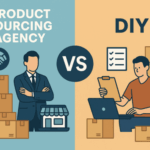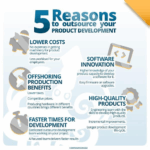In today’s rapidly changing world of commerce, businesses solely rely on efficiency and cost-effectiveness. One really important part of running a business is buying things and getting the best deals. That’s called sourcing and procurement. And guess what? It’s changing a lot because of cool new technologies! One of these cool technologies is called automatic sourcing, and it’s making a big difference in how companies buy stuff.
Understanding Automated Sourcing
The procurement process is the backbone of businesses because it’s all about buying the right things at the right price. Whether it’s about e-commerce product sourcing or local market sourcing, automatic sourcing utilizes smart technology that helps businesses find and buy the things they need quickly and efficiently. It uses computers and clever algorithms to search for the best deals from different suppliers, saving time and money.
For instance, suppose your company needs to purchase a large quantity of pencils for its employees. If conducted traditionally, this process may involve manual searching through multiple suppliers, and price negotiation, with constraints of timely delivery. A time-consuming process requiring significant effort!
In contrast, automatic sourcing would swiftly identify the most cost-effective suppliers, negotiate favorable terms, and even anticipate future needs to optimize bulk purchasing. Automated sourcing also helps build better relationships with the companies you buy from. This not only saves valuable time but also maximizes cost savings for the company.
How Automatic Sourcing Works
Automated Sourcing simplifies the complex procurement processes with efficiency and perfection. Thanks to this autonomous procurement, several tasks can be completely automated without the involvement of humans.
At its core, automated sourcing handles the repetitive and monotonous tasks of finding and engaging suppliers by utilizing data analytics with AI and machine learning technologies. Automated sourcing covers every aspect of a business. From initial product research, market analysis, and even issuing RFQs (Request for Quotation), to even managing the contractual side of supplier relations everything falls under the shadow of automated sourcing. There are several product sourcing and procurement agencies, offering their procurement services to businesses. Let’s have a sneak peek into the process to grasp a better understanding of the process.
- Data Collection and Analysis:
Automatic sourcing begins with data collection and analysis. It includes gathering information from different sources, like historical purchasing data, market trends, and supplier catalogs
For example, suppose a company needs to get office supplies. Automatic sourcing would collect data on past purchases, analyze market prices for similar products, and identify suppliers offering the most competitive rates.
- Supplier Identification and Qualification:
Next to data analysis is the process of identifying qualified suppliers. At this stage, automated sourcing evaluates supplier credentials and picks out the best suppliers that can meet the company’s needs in terms of reliability, reputation, and product quality.
For instance, in a manufacturing context, automatic sourcing may check suppliers for their production capacity, proximity, and adherence to industry standards.
- Negotiation and Contract Management:
Automatic sourcing also helps negotiate and manage contracts to ensure favorable terms and conditions. With predefined negotiation structures and real-time market insights, the automated system negotiates with suppliers and secures the best possible deal. Once terms are agreed upon, it streamlines the contract management process and enables seamless communication between the parties.
- Order Fulfillment and Delivery:
In an e-commerce context, let’s say a customer purchases a laptop from an online retailer. Automatic sourcing will immediately generate a purchase order and send it electronically to the laptop supplier. It’s the final stage of automated Sourcing where orders are fulfilled and delivered smoothly.
Once contracts are finalized, automated systems generate purchase orders and send them electronically to suppliers. Throughout the process, automatic sourcing keeps an eye on the order status, tracks shipments, and ensures that deliveries are made on time.
The Benefits of Automating Sourcing Practices
With automated sourcing, businesses can unlock an array of benefits as they march toward operational excellence:
- Time Efficiency
Time is the most valuable asset of any business. The primary benefit of automatic sourcing is its potential for significant time-saving. Automatic sourcing streamlines the procurement process by reducing manual interventions and time-consuming tasks such as supplier selection, price comparison, or order placement.
Consider a situation where a business urgently requires equipment for a new project. With automatic sourcing services, the procurement team can efficiently find reliable suppliers and accelerate the purchasing process. This will result in timely project execution without sacrificing quality or facing any financial constraints.
- Cost Savings
Automation and algorithms are helping businesses by speeding up performance while reducing human errors. Now businesses can reduce direct procurement costs shake off the fear of overstocking and eliminate wastage. By leveraging automation, businesses can also identify the best sourcing suppliers or sourcing manufacturers and negotiate better pricing for their goods and services, adding up to immediate cost savings.
For instance, if a company needs to procure raw materials for production, automatic sourcing can swiftly pinpoint suppliers offering competitive prices which will result in considerable cost savings over time.
- Improved Supplier Relationships
Automation also helps businesses maintain consistent and transparent relationships with their suppliers. When procurement is automated, the process runs faster overall, resulting in quicker response times and improved communication. This collaboration can make suppliers more open to your requests and help to foster a better supplier relationship.
Implementing Automatic Sourcing in Your Business
To successfully implement automatic sourcing, businesses need to follow some key steps.
- Define Your Sourcing Objectives: Establish clear objectives for your automatic sourcing initiatives. These could include cost savings, improved supplier relationships, or enhanced compliance, among others.
- Develop Sourcing Rules: Create sourcing rules and guide the automatic sourcing process accordingly. This may involve specifying preferred suppliers, blanket purchase agreement terms, distribution assignments windows, and more.
- Implement an Automatic Sourcing Solution: Select and implement an automatic sourcing solution that easily integrates with your existing procurement systems. This may involve working with a third-party provider.
- Monitor and Optimize: Don’t forget to monitor the performance of your automatic sourcing system. Make frequent adjustments to maximize its effectiveness.
Final Thoughts
Automatic sourcing means the use of technology and automation in the sourcing process. It helps businesses improve their procurement strategies by automatically purchasing assigned goods and services from the most suitable suppliers. Automated sourcing agencies leverage artificial intelligence, machine learning technology, and data analytics to reduce work errors while helping businesses to save their time and cost.








